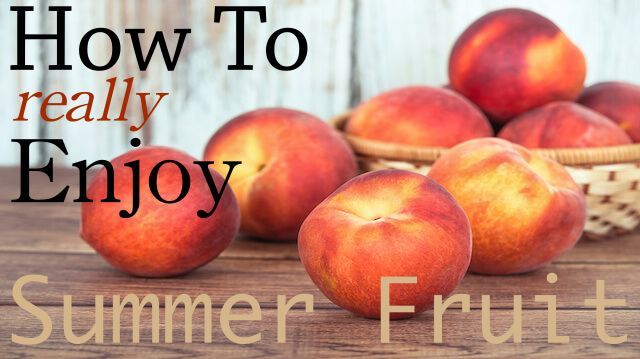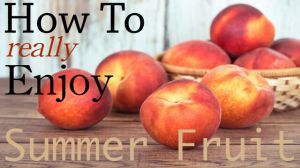
Have you ever stopped to think about that peach you’re eating, and how far it traveled to get to your plate? Let’s imagine two scenarios.
In the first story, the peach grows on a tree in a large commercial farm in a distant country where the climate is warmer. It is picked when it is still hard as a rock and maybe even has a green tinge to its skin. This is because the peach cannot be left to ripen in the sun, as it is about to go on a long journey. It is picked and binned, and shipped to a central facility where it is packed into crates. It goes through various formalities of export before being imported to your country via mass freight.
The peach arrives at a warehouse where it stays for some time and is exposed to a gaseous ripening agent before eventually being trucked to your supermarket. It is handled by shipping staff and stocking staff and lots of other shoppers before it finally makes it into your plastic produce bag.
At this point the peach hasn’t seen the sun for days and has lost many of its antioxidants and vitamins, and much of its flavor. It is a little bruised from all of the shipping and handling, and generally is a sorry excuse for its kind.
Now on to the second scenario. Here we have a peach growing on a tree in a medium-sized, family-run orchard a short drive outside of your town. It is allowed to ripen in the sun until it is blushing with red and yellow hues, and nearly bursting with sweet juices. It is plucked from the tree at its prime and placed in a basket, which the farmer brings to your farmer’s market the next morning. You pick up the basket of fragrant peaches and take them home to enjoy. You are eating them within a couple of days of picking, meaning that you are able to enjoy the full spectrum of vitamins and antioxidants that a peach should ideally offer.
Which sounds more natural, gratifying and appetizing? You probably answered the second one!
The first peach has decreased nutritional value and an increased carbon footprint, as compared to the ideal nutrition and sustainable business model of the second peach. This is just one of the reasons why eating seasonally is so important.
 These days we have a hard time naming what is in season at any given time. Most of us might know that strawberries become ripe and are picked as things warm up following the spring, tomatoes are ready in the heat of summer, and apples are harvested in the autumn.
These days we have a hard time naming what is in season at any given time. Most of us might know that strawberries become ripe and are picked as things warm up following the spring, tomatoes are ready in the heat of summer, and apples are harvested in the autumn.
But what about brussel sprouts, or plums, or currants? With the recent slow food and local food revolutions starting at the grassroots level, people are making the effort to get back in touch with the natural cycles of the earth and what amazing foods are offered up at different times of the year.
The long, warm days of summer give us a mind-boggling array of different fruits and berries. Here is a summary of the different types of summer fruit to look out for in the coming months, and some tips on developing a keen eye for the best specimens.
Fruits in season now:
- Apricots: In the United States, nearly all of the commercially-sold apricots are grown in California, but some also come from Washington and Utah. Worldwide, China and Turkey are the largest producers. It’s worth seeking out a small-scale local source of these delicate sweet gems. If you live in the right climate, ripe apricots will be available through May, June, July and August. Nutritionally, you will benefit from good doses of Vitamin A, Vitamin C, potassium and fiber. If you have some apricots at home that are too firm, try placing them in a paper bag for 1–2 days with the company of a banana or apple. Once they yield to pressure (but before they begin to feel mushy), enjoy those apricots right away!
- Plums: Plums are in season in late summer, around August and September (in North America). California is the most prolific plum-growing area in the U.S. with fruit being produced for several months of the year. It’s best to seek out organic plums, since conventionally grown plums can have over 40 different pesticide residues on their skin. Try the many different varieties, which range from green and yellow to dark purple, and can be as small as a grape or as large as an apple. Enjoy fresh or preserved plums for your daily dose of potassium, vitamin C and fiber, plus disease-fighting phenols. When choosing plums, ensure the skin is taut and smooth with a little bit of softness. If you want to ripen plums that are too firm, put them in a plastic bag with an apple or banana.
- Cherries: The United States is the world’s second largest producer of cherries, following Turkey. The main producing states include New York, Pennsylvania and Utah for sour cherries, and Washington and Oregon for sweet cherries. Cherries are highly perishable so buying them locally within just a few days of picking, around late June and July, is your best bet. This should also help cut down on the pesticide load, since they rank pretty high in the Environmental Working Group’s Dirty Dozen list. Cherries boast a range of antioxidants plus potassium, vitamin C and fiber. They even have anti-inflammatory anthocyanins, which are believed to fight disease.
- Blackberries and raspberries: July and August bring a bountiful berry crop throughout most of North America. Also called “brambles,” these jewel-like berries come in a range of colors from pale yellow to red to almost black. Brambles rank in the medium range as far as pesticide load goes, so organic is best, but local conventional berries should be okay too. Both raspberries and blackberries rank in the top 10 list for the highest antioxidant content, and the polyphenols found in color pigments are no slouch either. Be sure to choose firm berries that have been freshly picked, since they turn mushy and grow mold very quickly. Making jam or freezing are good ways to preserve large amounts of berries.
- Nectarines: The time for nectarines is from late July into early autumn. As with many other fruits, nectarines are frequently treated with pesticides so it is wise to choose organic. This fuzzless cousin of the peach serves up lots of fiber and vitamin C, and goes great with yogurt and gluten-free granola. Choose smooth and shiny nectarines that are still a little firm, since they lose flavor when they get too soft.
- Strawberries: There’s nothing quite as sweet as picking your own strawberries and piling them into baskets to make jam or strawberry shortcake. They are available from late May through early July. The strawberries you’ll find at the local fruit stand or farmers’ market are a far cry from the giant flavorless ones shipped into the supermarket. Local strawberries are small, bright gems bursting with flavor, and correspondingly higher levels of vitamins and antioxidants. Did you know strawberries are the only fruit that carry their seeds on the outside? Choosing organic and small-scale production here is very important, since strawberries rank as one of the absolute worst for pesticide use. Choose firm strawberries and remove any moldy ones. Waiting to wash them until just before you eat them helps them stay fresh longer.
- Peaches: Peaches are available throughout the summer in North America and are much-celebrated throughout the United States — they are an official fruit in three states and the focal point of many festivals. White peaches are sweeter while yellow ones have a little more pucker. Both have good levels of vitamin C and cancer-fighting anthocyanins. Choosing peaches is easy if you follow your nose to the most fragrant fruit with no bruises.
- Melons: Melons can be enjoyed from mid-summer through to early fall. The top-producing states are California, Arizona, Texas, Georgia and Florida, since melons need ample sun to grow and become ripe. You’ll find that local melons have much more flavor and juice than anything you would find at a breakfast buffet at a hotel chain. Since the skin is not eaten, melons belong to the Environmental Working Group’s Clean 15 list, but it’s still wise to ask your local farmer about their growing practices. Choose a good fruit by weighing it in your hand — it should be heavy and have no soft spots or damage to the skin. You will be rewarded with plenty of vitamins A and C, potassium, folate and fiber, as well as beta-carotene among other antioxidants.
Check out your local farmers’ market this weekend, or go the next step and join a CSA (Community Supported Agriculture) so that you have a steady supply of local produce coming in. Not only will you enjoy the fresh flavors of the earth and support hard-working farmers in your area, your body will gain vitality from the abundant nutrition that seasonal fruit contains. Need some inspiration for what to make with all that bounty? Start here with some info on ripe summer melons.
—The Alternative Daily
Sources:
http://www.motherearthnews.com/real-food/seasonal-eating-zmaz07aszgoe.aspx
http://www.sustainabletable.org/seasonalfoodguide
http://www.naturalnews.com/035575_seasonal_food_diet_health.html
http://www.fruitsandveggiesmorematters.org/whats-in-season-summer
http://www.pbs.org/food/fresh-tastes/whats-in-season-during-the-summer
http://www.thekitchn.com/the-seasonal-produce-i-put-in-my-freezer-love-your-freezer-216217
http://www.marthastewart.com/276955/seasonal-produce-recipe-guide
http://www.gracelinks.org/blog/2158/real-food-right-now-and-how-to-cook-it
http://www.whfoods.com/genpage.php?tname=foodspice&dbid=42
http://www.ewg.org/foodnews
http://www.whatsonmyfood.org/food.jsp?food=PU
http://www.beyondpesticides.org/organicfood/conscience/navigation.php?foodid=34
http://www.agmrc.org/commodities__products/vegetables/melon-profile

